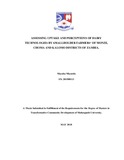Please use this identifier to cite or link to this item:
https://space.mu.ac.zm/xmlui/handle/123456789/148Full metadata record
| DC Field | Value | Language |
|---|---|---|
| dc.contributor.author | Miyanda, Mayaba | - |
| dc.date.accessioned | 2019-05-28T09:17:23Z | - |
| dc.date.available | 2019-05-28T09:17:23Z | - |
| dc.date.issued | 2018-05 | - |
| dc.identifier.uri | https://space.mu.ac.zm/xmlui/handle/123456789/148 | - |
| dc.description.abstract | The use of dairy technologies can substantially increase farm productivity and income. Despite this fact, adoption of such technologies has been generally low among smallholder farmers in developing countries. The purpose of this study was to assess uptake and perceptions of dairy technologies by smallholder farmers of Monze, Choma and Kalomo districts of Zambia. The study sought to identify dairy technologies that had been introduced, factors influencing the uptake and farmers understanding of the technologies. A cross-sectional study was carried out and data was collected from 104 smallholder dairy farmers who were members of milk collection centers. The farmers were randomly selected using the simple random sampling technique. Data was collected using a structured questionnaire and analyzed using descriptive statistics. The dairy technologies investigated in this study included improved dairy breeds, artificial insemination, estrus synchronization, improved animal nutrition, improved animal health and structures. Results on training of farmers in animal nutrition and structures showed that a majority response of 62% was obtained. An average milk yield of 16 liters per animal per daywas reported by the farmers. Dairy technology uptake indicated that the least adopted were breeding technologies, artificial insemination (60%) and estrus synchronization (44%). Knowledge levels indicated that they understood the importance of incorporating them in milk production. These results suggest that dairy technology uptake among smallholder farmers in Zambia is sustainable. However, poor access of breeding technologies, lack of affordable and quality dairy breeds, poor access of pasture seed and inadequate feed, inadequate land, inadequate extension visits, inadequate training, poor sensitization and dissemination of information are some of the major hindrances of dairy technology uptake. From the study findings, it is recommended that the Government and donors need to allocate more resources toward animal breeding services, fodder seed production and extension service delivery. Projects should also consider initiating financial lending services for individual smallholder dairy farmers at low interest rates with flexible modes of payment. | en_US |
| dc.language.iso | en | en_US |
| dc.subject | Daily farming, Daily technology. | en_US |
| dc.title | Assessing uptake and perceptions of dairy technologies by smallholder farmers’ of Monze, Choma and Kalomo districts of Zambia. | en_US |
| dc.type | Thesis | en_US |
| Appears in Collections: | Transformative Community Development | |
Files in This Item:
| File | Description | Size | Format | |
|---|---|---|---|---|
| FINAL REPORT, Mayaba Miyanda 2018.pdf | 2.48 MB | Adobe PDF |  View/Open |
Items in DSpace are protected by copyright, with all rights reserved, unless otherwise indicated.
